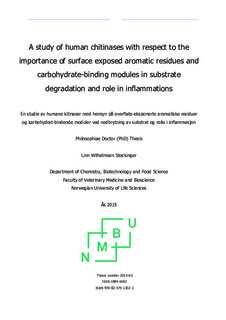| dc.contributor.advisor | Sørlie, Morten | |
| dc.contributor.advisor | Lea, Tor | |
| dc.contributor.advisor | Kleiveland, Charlotte R. | |
| dc.contributor.advisor | Hult, Lene Olsen | |
| dc.contributor.author | Stockinger, Linn Wilhelmsen | |
| dc.date.accessioned | 2018-05-03T11:15:58Z | |
| dc.date.available | 2018-05-03T11:15:58Z | |
| dc.date.issued | 2018-05-03 | |
| dc.identifier.isbn | 978-82-575-1302-3 | |
| dc.identifier.issn | 1894-6402 | |
| dc.identifier.uri | http://hdl.handle.net/11250/2496969 | |
| dc.description.abstract | Chitin is an insoluble, linear polymer consisting of β-1, 4-linked N-acetyl-glucosamine units tightly packed in a crystalline structure. It is the second most abundant polysaccharide in nature, after cellulose, with an estimated annual production of about 1011 tons. Chitin is an essential structural component in the exoskeleton of crustaceans, arthropods, and insects, and is also found in the cell walls of certain fungi, algae, and parasitic nematodes. Enzymatic degradation of recalcitrant polysaccharides in biomass is of great biological importance. In nature, the degradation of chitin is catalyzed by chitinases, which are assigned to the glycoside hydrolase (GH) family 18 in the CAZY database (www.cazy.org). Humans have two active chitinases that are considered elements of the immune system because they degrade chitin-containing pathogens as a part of the host defense mechanism. The aim of the work presented in this thesis was to study the enzymatic mechanisms of one
of the human chitinases, namely the human chitotriosidase (HCHT), to gain mechanistic insight into substrate degradation. A second goal was to study the expression of mammalian chitinases and chitinase-like proteins (CLP) in response to specific inflammatory stimuli to increase knowledge about the enzymes’ roles in the immune system. | nb_NO |
| dc.description.abstract | Kitin er en uløselig, lineær polymer bestående av β-1, 4-linket N-acetyl-glykosamin enheter tett pakket i en krystalinsk struktur. Etter cellulose er kitin det polysakkaridet i naturen det er størst forekomst av. Kitin er en viktig strukturell komponent i skalldyr, insekter og sopp, og er også tilstede i celleveggen til enkelte sopper, alger og parasitter. Til tross for de enorme mengdene kitin som produseres årlig akkumulerer ikke kitin i naturen. Dette skyldes en mengde proteiner som effektivt er med på enzymatisk nedbrytning av kitin, kjent som kitinaser. Humane kitinaser er også involvert i immunsystemet og i nedbrytning av kitin-holdige patogener. Formålet med dette prosjektet har vært å studere de enzymatiske mekanismene til en av de humane kitinasene, human kitotriosidase (HCHT). Dette for å tilegne kunnskap om mekanismene bak nedbrytning av polysakkarider. I tillegg ble rollen til mammalske kitinaser studert i en spesifikk inflammasjon for å øke kunnskapen om disse enzymene i immunsystemet. | nb_NO |
| dc.language.iso | eng | nb_NO |
| dc.publisher | Norwegian University of Life Sciences, Ås | |
| dc.relation.ispartofseries | PhD Thesis;2015:63 | |
| dc.title | A study of human chitinases with respect to the importance of surface exposed aromatic residues and carbohydrate-binding modules in substrate degradation and role in inflammations | nb_NO |
| dc.title.alternative | En studie av humane kitinaser med hensyn på overflate-eksponerte aromatiske residuer og karbohydrat-bindende moduler ved nedbrytning av substrat og rolle i inflammasjon | nb_NO |
| dc.type | Doctoral thesis | nb_NO |
| dc.source.pagenumber | 1 b. (flere pag.) | nb_NO |
